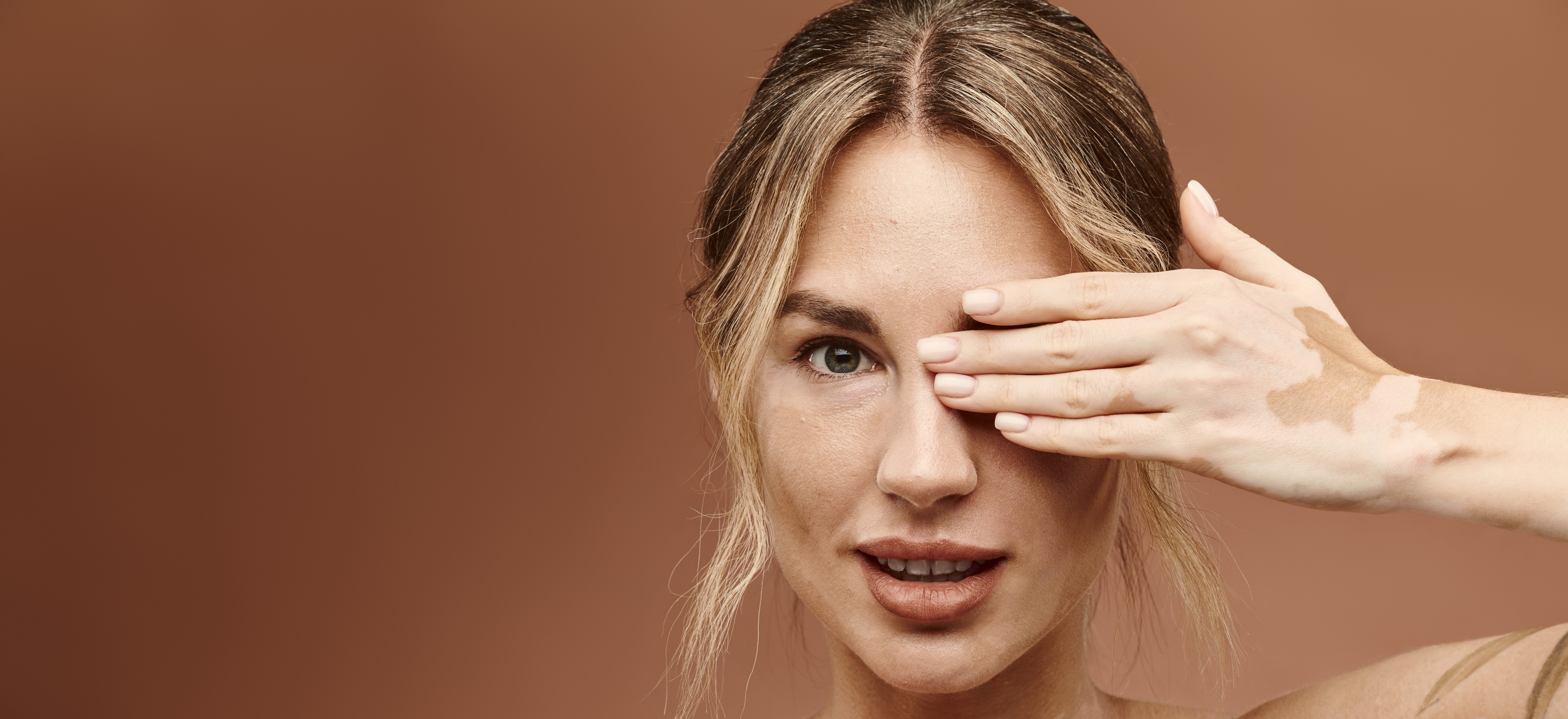
What is Vitiligo? A Simple Guide
Vitiligo is a skin condition where patches of your skin lose their color. These lighter spots can pop up anywhere and might get bigger over time. This happens because the cells that give your skin its color, called melanocytes, stop working or die.
It’s more than just how you look. While vitiligo doesn’t cause any physical harm, it can really affect how you feel about yourself, especially if the spots show up on your face or hands.
Anyone can get vitiligo, no matter their age, skin tone, or background. Millions of people around the world live with it.
What is Vitiligo
Vitiligo is a skin condition where some areas lose their natural color and turn lighter. This happens because the cells that give your skin its color, called melanocytes, stop working or disappear. Without these cells, your skin cannot produce melanin, the pigment that colors your skin, hair, and eyes.
These lighter patches can appear anywhere on your body. You might notice them first on your hands, arms, face, or around your mouth and eyes. Others might see them on their feet, knees, or even inside their mouth. Sometimes, the hair in those spots can turn white or gray too. The patches can be small or large, and they might spread slowly over time or stay the same for years.

Common Signs of Vitiligo
Vitiligo usually starts with small changes in your skin color. Here are some signs to look out for:
- White or light spots on your skin – These can appear suddenly and often stand out more if your skin is darker.
- Spreading patches – Sometimes the light spots stay the same size, but other times they slowly grow or show up in new places.
- Hair turning white early – Hair, eyelashes, or eyebrows in the affected areas might turn white or gray sooner than usual.
- Loss of color inside your mouth or eyes – Some people notice lighter spots on their lips, inside the mouth, or changes in eye color.
- Usually no pain or itching – Vitiligo doesn’t typically hurt or itch. Your skin will feel normal, even if it looks different.
While vitiligo isn’t harmful, it can affect how people feel about their appearance. That’s why understanding it and finding support can really make a difference.
Is Vitiligo Contagious or Dangerous
No, vitiligo isn’t contagious. You can’t catch it from someone else, and it doesn’t spread by touching or sharing things.
It’s also not dangerous to your health. Vitiligo won’t make you sick or cause serious problems. It mainly changes the way your skin looks, but doesn’t affect how your body works.
That said, it can be tough emotionally. When patches show up on places like your face or hands, it’s normal to feel self-conscious or upset. Just know you’re not alone, and vitiligo doesn’t define who you are.
What Causes Vitiligo
Vitiligo happens when your body’s immune system accidentally attacks the cells that give your skin its color. These cells are called melanocytes, and when they get damaged, some patches of your skin lose their color.
There might be a few different reasons why this happens. Sometimes vitiligo runs in families, so your genes could have something to do with it. People often notice it after going through a lot of stress, being sick, or after a skin injury like a bad sunburn. There might be other things in the environment that play a role, but scientists are still figuring that out.
The truth is, no one really knows exactly why vitiligo starts. It’s probably a mix of several things coming together. The good news is, it’s not caused by anything you did, and it’s definitely not your fault.
Types of Vitiligo
Vitiligo can show up in different ways depending on where it appears on your body. Doctors usually talk about a few main types:
- Non-segmental vitiligo is the most common kind. It usually shows up on both sides of your body in a similar way, like matching white patches on both hands, knees, or both sides of your face. It often starts small and slowly spreads over time.
- Segmental vitiligo tends to happen on just one side or one area, like one arm, leg, or half of your face. It usually starts earlier in life and spreads a little before stopping.
There are also terms to describe how much of your body is affected:
- Focal vitiligo means there are just a few patches in one small area.
- Generalized vitiligo means the white patches appear in lots of different places.
- Universal vitiligo is very rare but it means almost your entire body is affected.
Everyone’s vitiligo is a bit different. Some people barely notice changes over the years while for others it spreads more.
Who Can Get Vitiligo
Vitiligo can affect anyone, no matter your age, skin color, or background. People with all skin tones can get it, though the lighter spots usually show up more on darker skin.
It most often starts before you turn 30, but it can happen at any age, whether you’re a kid or an adult.
If someone in your family has vitiligo, you might be a little more likely to get it too. That means it can run in families, but it doesn’t mean you definitely will. Lots of people without any family history still get vitiligo.

How is Vitiligo Diagnosed
If you notice white patches on your skin, the first step is to see a doctor, usually a skin specialist called a dermatologist. Most of the time, they can tell if it’s vitiligo just by looking at your skin.
Sometimes, the doctor may use a special UV light called a Wood’s lamp. This helps them see areas where the skin has lost color that might be hard to spot in normal light.
The doctor might also order blood tests to check for other health problems that can happen with vitiligo. In rare cases, they may take a tiny skin sample to look at under a microscope.
Overall, diagnosing vitiligo is usually simple with a careful exam and the right tools.
Can Vitiligo Be Treated
There’s no cure for vitiligo yet, but there are ways to help restore some color or keep it from spreading. How well these treatments work can vary a lot from person to person.
Some of the common options include:
- Creams that calm the immune system or encourage your skin to produce pigment again
- Light therapy, where your skin gets controlled exposure to special ultraviolet light
- Pills that might support treatment or help control the immune response
- Sometimes, surgery or skin grafts are used to replace the affected skin with healthy skin
Keep in mind, results aren’t the same for everyone. Some people see good changes, while others don’t notice much difference. Treatment takes time and patience. Working closely with a dermatologist can help you figure out what’s best for you.
Living with Vitiligo
Living with vitiligo means taking care of your skin and yourself in a way that helps you feel your best. Here are some simple ideas that many people find helpful:
Protect your skin from the sun
The lighter patches on your skin don’t have much pigment, so they’re more likely to get sunburned. Wearing sunscreen, hats, and clothes that cover your skin can help keep you safe and comfortable.
Use makeup or skin products if you want
Some people like to use makeup or special creams to even out their skin tone. These can help boost your confidence and make you feel more at ease in your own skin.
Find support when you need it
Vitiligo can sometimes affect how you feel emotionally. Talking with friends, joining support groups, or seeing a counselor can make a big difference. Focusing on what makes you unique can help you embrace your look and feel good about yourself.
Remember, vitiligo is only one part of who you are. There are lots of ways to live well and feel happy with it.
When to See a Doctor
If you’ve noticed white patches on your skin that aren’t fading or seem to be spreading, it’s a good idea to check in with a doctor. They can help figure out what’s causing it and make sure it’s not something else that looks similar.
It’s also a chance to talk about treatment options and get some helpful tips for taking care of your skin. The earlier you go, the easier it is to understand what’s going on and what you can do about it.
Caring for Vitiligo with Confidence
Vitiligo changes how your skin looks, but it doesn’t change who you are. It’s not contagious or dangerous, but it can affect how you feel about yourself.
The more you know about vitiligo, the easier it is to feel supported and confident.
At Palm Beach Dermatology Group, we’re here to help. With over 40 years of experience, our team offers treatments, guidance, and care tailored to your needs. Whether you’re exploring treatment options or just looking for answers, we’re ready to walk with you every step of the way.
If you’re noticing signs of vitiligo, or if someone you care about is, schedule an appointment with us. Let’s talk about your skin, your goals, and how we can help you feel confident again.
FAQs
Is vitiligo contagious?
No, vitiligo isn’t contagious. You can’t catch it from someone else by touching them, being close, or sharing things. It’s an autoimmune condition, which means it happens inside the body and isn’t caused by germs or infections.
Does vitiligo cause health problems?
Vitiligo itself doesn’t cause any physical harm or serious health issues. But it can sometimes be linked to other autoimmune problems like thyroid disorders or diabetes. Many people find it hard emotionally because it changes how their skin looks. It’s normal to feel self-conscious or anxious, and getting support can really help.
Can vitiligo go away on its own?
Sometimes, patches may get some color back without treatment, but that’s pretty rare. Usually, the patches either stay the same or spread slowly over time. Treatments can sometimes help bring back color or stop it from spreading, but it varies from person to person.
Can kids get vitiligo?
Yes, kids can get vitiligo too. If it shows up early, it’s important for parents to support their child and talk to a doctor. Early diagnosis can make managing the condition easier and help with any worries the child might have.
Does stress make vitiligo worse?
A lot of people notice stress or big life changes can trigger vitiligo or make it spread faster. Stress alone doesn’t cause it, but managing stress with things like relaxation, counseling, or healthy habits can help your overall health and might slow down flare-ups.
Is there a special diet for vitiligo?
There’s no specific diet that will cure or prevent vitiligo. But eating a balanced diet with plenty of fruits, veggies, and whole foods supports your immune system. Some people find that avoiding foods that cause inflammation helps their skin, but it’s different for everyone.
Can people with vitiligo go out in the sun?
Yes, they can, but they need to protect their skin. The white patches don’t have pigment, so they burn more easily. Using sunscreen, wearing hats, and avoiding the strongest midday sun will help keep skin safe.
Can vitiligo affect hair color?
Yes, it can cause patches of hair to turn white or gray. This happens when the cells that give hair its color are affected. It can show up on the scalp, eyebrows, eyelashes, or beard, and sometimes this is one of the first signs.
Is vitiligo hereditary?
Vitiligo can run in families, so genes might play a role. If someone close to you has it, your chances are a bit higher, but it doesn’t mean you’ll definitely get it. Lots of people develop vitiligo without any family history.
Can vitiligo affect the eyes or inside the mouth?
Yes, vitiligo can cause loss of color inside the mouth, like on the gums or inner cheeks. It can also affect the colored part of the eyes. Usually, this doesn’t cause pain or affect vision, but your doctor may check for it during exams.
